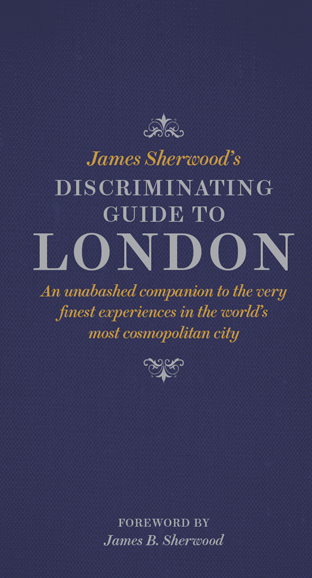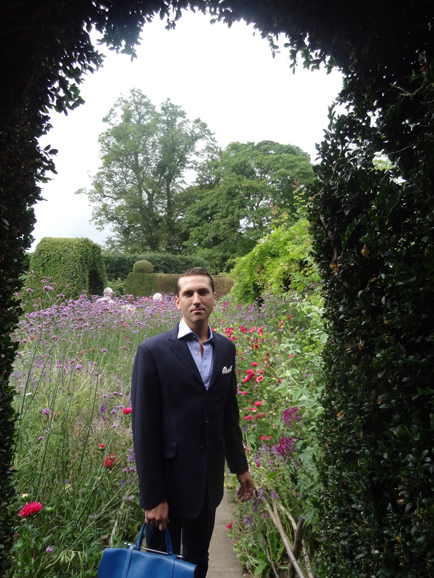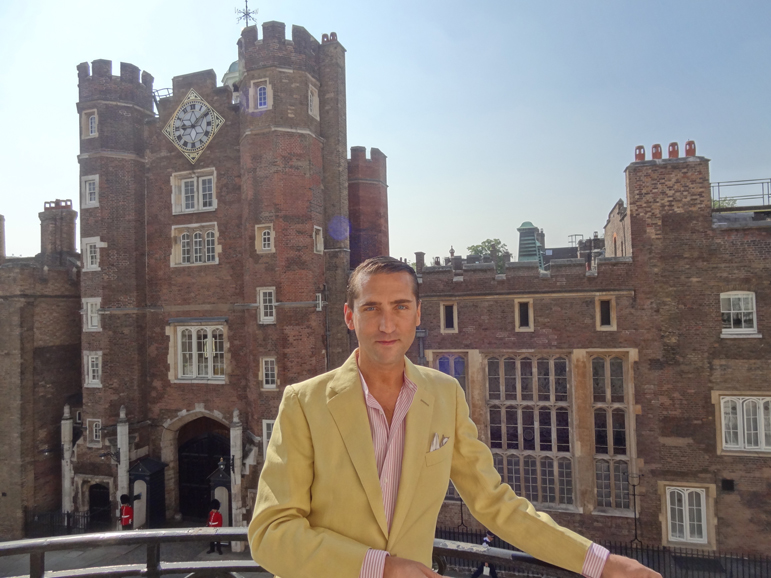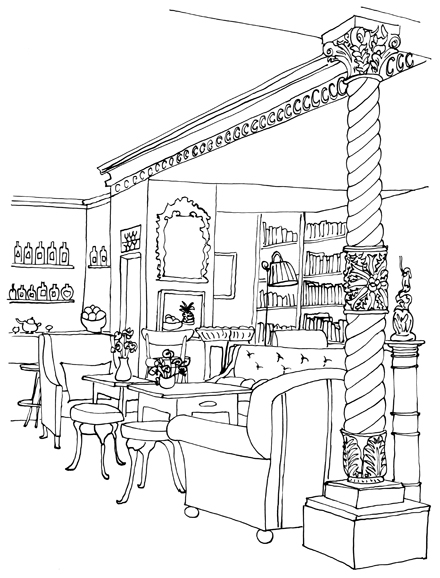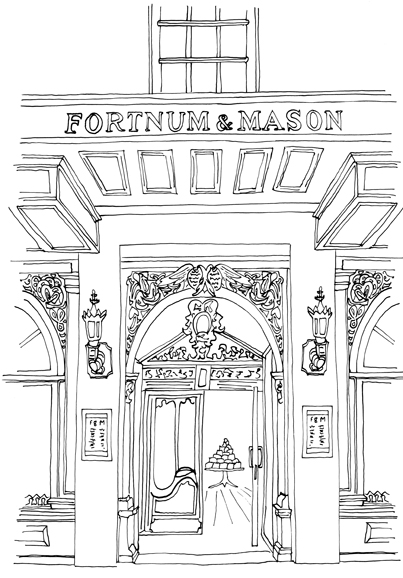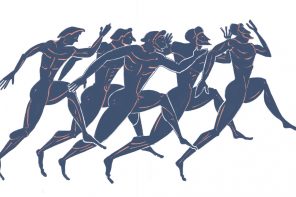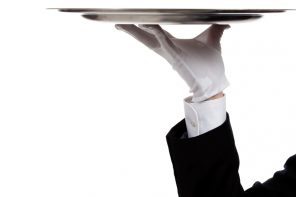Headed to London this season, perhaps for the official celebration of Queen Elizabeth II’s 90th birthday June 10 through 12? Why not take James Sherwood along? Well, not literally, of course, as he’s already there. But rather, why not slip his new “Discriminating Guide to London” (Thames & Hudson, 432 pages, $29.95) into your Louis Vuitton overnighter or Birkin bag?
If anyone should know the city, it’s this style guru – the archivist at the bespoke tailor Henry Poole & Co. and a consultant for the Savile Row company Anderson & Sheppard as well as The Savoy hotel.
Editor-at-large for The Rake, Sherwood contributes to The Daily Telegraph and The World of Interiors magazine. He was the BBC fashion critic at Royal Ascot for eight years and regularly appears as a royal style and fashion critic on British and American TV. His previous books include “Savile Row: The Master Tailors of British Bespoke, “Fashion at Royal Ascot” and “The Perfect Gentleman: The Pursuit of Timeless Elegance and Style in London,” all of which have established him as a witty writer.
Here he is on J Sheekey Oyster Bar: “Marilyn Monroe, who wasn’t dumb and wasn’t blonde, observed astutely that ‘glamour cannot be manufactured.’ This applies to restaurants as well as to the most fabulous 1950s blonde: you either have it or you’ve had it….So it is with huge respect, a standing ovation and a rush of endorphins that we applaud the perennial glamour puss opened by Josef Sheekey in 1896, when Queen Victoria was still on the throne.”
And it is with respectful endorphins that WAG poses these 10 questions:
1. Your guide is subtitled “An unabashed companion to the very finest experiences in the world’s most cosmopolitan city.” What makes London different from the other great cities of the world?
“Without wishing to offend New York, Beijing, Paris or Moscow, I think London is the most consistent of all the candidates for ‘world’s most cosmopolitan city.’ The population has always welcomed those wishing to settle here from foreign countries and contribute to the richness – both literal and metaphorical – of life in London. Similarly, the city has for the most part been a safe and open destination for the world’s wealthiest travelers for many centuries. Paris, Moscow and Beijing may be comparable in age and perhaps in beauty to London, but France, Russia and China did have a propensity to cut their emperors’ heads off or assassinate them, making these cities no-go areas time after time. London was and is a place of greater safety.
“In the year that we celebrate Her Majesty The Queen’s 90th birthday, I think it appropriate to say that the British monarchy has been a stabilizing force in London and a great attraction for visitors. There is something reassuring for Londoners and visitors that the city’s palaces are still occupied by a royal family. This isn’t a dead city like St. Petersburg where the history is frozen in aspic.
London’s history has been turbulent, too. The Great Fire in 1666, the Blitz of 1940-41 and the present epidemic of demolition and redevelopment have all changed the architectural face of London. And yet, enough of historic London has survived to make it a familiar destination even for people who have never visited. London does not wallow in nostalgia either. It is a city constantly looking to the future like New York. For fans of ‘Downton Abbey,’ if New York is a debutante, then London is the Dowager Countess.
2. The real New York offers a contrast to movie New York. How does the real London compare to the media view of the city?
“I think the beauty of London is that it doesn’t contrast with the ‘movie London.’ ‘Red London’ will never fail to please visitors – the scarlet pillar boxes and phone boxes, the red buses and the red uniforms worn by the guards outside Buckingham Palace are all present and correct. Those who like costume drama London can find a Dickensian flavor in Clernekwell, Borough and Bermondsey; the 18th century aristocratic dream in St. James’, Mayfair and the Royal Parks; the grit of ’50s crime drama in Soho and the groove of Swinging ’60s London on Carnaby Street and Jermyn Street.
“The high rises growing in the City and Canary Wharf are not popular with the locals, but they do offer a thrilling new 21st century skyline for visitors. All of London’s villages will be very familiar to film buffs – Notting Hill, Bloomsbury, Hampstead, Covent Garden and Brixton to name a very few. I suppose that London is so familiar in movies, literature and history that visitors actually do feel a sense of ownership if not déjà vu when they finally do come face-to-face with Buckingham Palace, the National Gallery or Battersea Power Station. That is the city’s magic.’
3. Your book was inspired by the original 1975 guide by another James Sherwood, James B. Sherwood (no relation), who owns the Orient-Simplon Express as well as luxury hotels and restaurants and has contributed the foreword to your guide. A bit of déjà vu?
“More than a bit of dèjà vu. When I first came to London, I lived in the then less-than-salubrious Clapham North district south of the river. A dinner party guest, the men’s accessory designer Simon Carter, bought me an antique copy of Mr. Sherwood Sr.’s “Discriminating Guide to London.” I loved the book, the tone and the window on London in the 1970s. So when Thames & Hudson asked what I’d like to do after my “The Perfect Gentleman” book, I asked if I could revive “James Sherwood’s Discriminating Guide to London” in 2016. I met Mr. Sherwood Sr., who very graciously allowed me to use the title and – having read my new text – agreed to write the very complimentary foreword.
“I make no apologies that this book is entirely based on Mr. Sherwood Sr.’s original, even though the way my version was written – by the author alone – differs from the protocol in the 1970s when Mr. Sherwood’s friends reviewed the restaurants and hotels under discussion. The difference between then and now is the boom in London restaurants and hotels. I reviewed roughly the same number of restaurants (100, I think) but whereas in the ’70s there probably weren’t more than 200 to 300 restaurants that deserved consideration, now there would be more like 1,000. I had to be more discriminating and also very aware that even the best of the new London restaurants don’t necessarily survive.
4. I’m a business traveler with only one day in London. What must I do?
“Oh Lord! If you’re a business traveler only given one day off in London after a long haul flight then I really do feel sorry that you work for such an awful boss. I’d imagine you’d like to avoid the bovine tourist hoards and enjoy a little serenity in the city center. Weather permitting, do lose yourself for the morning in Hyde Park – it is, after all, larger than Monaco – before taking a taxi to the Wallace Collection in Manchester Square – the largest and loveliest collection of Rococo furniture and paintings in England placed as they were in a hidden aristocratic townhouse behind Oxford Street.
“Perhaps follow in the footsteps of Noël Coward and Gertrude Lawrence and lunch on half a dozen oysters and a glass of reviving Champagne at J Sheekey’s Oyster Bar in Covent Garden. Take a walk to the Millennium Bridge and cross for an afternoon at Tate Modern before taking your seats in Shakespeare’s Globe for a live performance or, if you prefer, a screening at the BFI (British Film Institute). If you’re feeling frisky, a nightcap in the bar above London’s oldest restaurant, Rules, should prepare you for bed in company or singularly.
5. I’m a jet-setter with all the time – and money – in the world. How do I do up the town?
“If money is no object, London will open up for you like an orchid. William Kent House is an exquisite 18th century property behind The Ritz that now forms an exclusive annex to London’s most famous hotel. There are only two suites – the Prince of Wales Suite and the Royal Suite – and both have the prettiest views over Green Park. Billet yourself in William Kent House using the magnificent red dining room with its Renaissance ceiling for a series of private dinners and cocktail parties for you and your guests. The West End is filled with private dealers in art, antiques, jewelry and gemstones, who will arrange viewings for serious clients as will the major auction houses Sotheby’s, Christie’s and Phillips. You could, for example, take a master class in tiaras at Piccadilly antique jeweler Bentley & Skinner or inspect Tudor portraits with British expert Philip Mould in his Pall Mall gallery.
The Ritz concierges will be able to secure private boxes with retiring rooms and bars in West End theaters, including the Royal Opera House. Take the private dining rooms at Scott’s, The Wolseley or the newly refurbished Ivy for a post-theater supper. Membership to private clubs such as Loulou’s and Annabel’s can be bypassed. Private views and dinners can also be arranged in London’s museums and galleries with sufficient notice. One of the most impressive venues to hire in entirety is the Richard Branson-owned Kensington Roof Garden with its acre and a half of landscaping, streams, follies and flamingos inspired by Spain’s Alhambra Palace and Sudeley Castle. Ordinarily a restaurant and private members’ nightclub, Kensington Roof Garden is a chic, surreal venue for an exotic private party.
6. I’m still a jet-setter but I like a bargain, too. Thoughts?
“Dial down the expense of a Michelin-star restaurant such as Hélène Darroze at the Connaught, Fera at Claridge’s or Angela Hartnett at Murano by booking a set lunch menu and keeping a very sharp eye on the wine list. Not much point spending under £50 (roughly $73) on three-courses only to blow £100 on the wine now is there? Jet-setters don’t tend to get an awful lot of sleep so perhaps sacrifice the grandeur of a famed West End hotel in favor of charm such as Soho’s Hazlitt’s Hotel or an up-and-coming location such as Bloomsbury’s Hoxton Holborn. Don’t, incidentally, be fooled by London’s endless happy hours and deals on drinks. You will be served absolute swill and feel ghastly in the morning.”
7. The one souvenir I must take from my London experience is…
“I’d go for an experience of a lifetime rather than a tin of biscuits from Fortnum & Mason or a Buckingham Palace tea towel. In May or June your timing is right to see The Queen at the State Opening of Parliament, Trooping the Colour or Royal Ascot. HM is now Britain’s longest-reigning monarch and a wave from that white-gloved hand thrills Londoners and our guests alike.”
8. How did you get to be a man of style, and what makes someone stylish?
“What makes someone stylish? Well, Beau Brummell used to say that if a man is well-dressed, you should not really notice him. This is abject nonsense, because the Beau was an exhibitionist extraordinaire. Any man who commits to a bespoke suit, shirt and tie in the 21st century is exceptional, because the standard of dress in London today is so low. You’ll see any number of men and women in the West End with tattoos and piercings that would frighten small children and make pets bark. So a suited gent is going to get attention, because he is an exception rather than the rule.”
9. When you’re in London, where will we find you?
“In London you will find me in Bloomsbury, where I live, and Mayfair, Piccadilly and St. James’s, where I work. I am currently researching a book about Henry Poole – the founding father of Savile Row – so I am most often to be found in the archives at No. 15 Savile Row, present home of Henry Poole & Co. The restaurants I enjoy most for lunch are Wiltons on Jermyn Street and J Sheekey’s Oyster Bar, the favorite café is Franco’s and barely a week goes by when I’m not dining after the theater at Queen Street and Joe Allen in Covent Garden. When I get rather weary of writing, I will go to Sir John Soane’s Museum, the British Museum, the National Portrait Gallery and the Wallace Collection to view art and antiques that are good for the soul.”
10. And when you’re out of town?
“For the past three years, practically all of my books and projects have been entirely focused on London so it has been a period of full immersion in the city I love. That said, one always loves a city more after time spent away. The northeast coast of Corfu, Nice, Menorca, Florence and Venice have all given me much pleasure and a little time to breathe, tan, drink the wine and come back to London refreshed.”
For more, visit thamesandhudsonusa.com.

